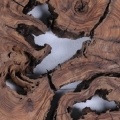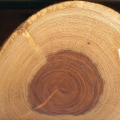
Mysterious olives
One of our projects is focused on using the olive, which is found abundantly in many archaeological sites throughout the southern Levant, in two ways: one is the investigation into the possible use of olive wood in dendrochronology, and the second is gleaning information about past climate by the δ13C measured in charred olive pits.
In order to be able to use olive wood in dendrochronology, and to access environmental information at an annual resolution, it must first be shown that olive wood growth represents a continued annual sequence that can be defined as such. It has already been shown (Cherubini et al., 2013) that basic dendrochronological methods of visually counting rings do not produce reliable and reproducible results for the olive tree. This work aims to identify whether the olive wood tissue grows continuously, representing an unbroken time sequence and if so, to find an alternative method of identifying annual rings. In our paper, published in Scientific Reports, we show that olive does grow annually, mainly during the spring and summer, and that this growth can be detected using δ13C intra-annual variations. We also show that micro-CT can detect most of the ring boundaries, even when the wood is charred. However, we found that the last 20 years or so, might not be detectable using the micro-CT.
Our study on the complexity of the olive growth patterns and the implications for age estimation of old olive trees was published in Frontiers in Plant Science. Furthermore, we found that radiocarbon dates of the last formed wood along the circumference are not chronologically homogenous, and can differ by up to a few decades. This means that the outermost wood layer does not necessarily represent the date of the last year of growth. These findings, which were also published in Scientific Reports, challenge the interpretation of the results obtained for dating the Santorini eruption (mid-second millennia BCE), using a buried olive branch - an event with far-reaching consequences in the archaeology of the Aegean, Egypt, and the Levant, and the understanding of their interconnections.
Regarding the δ13C signal from charred olive pits found at archaeological sites, it is essential to first understand the response of modern olive trees to different environmental conditions, and how this is reflected in the δ13C that is finally put down in the cellulose of the pits. To do so, mathematical models describing carbon fractionation and environmental effects (Δ13C) will be employed.

The Levantine origin of fava bean
In this study, we identified the oldest evidence for the domestication of the fava bean. The fava bean is a very important component of modern diets in areas as distant as Ethiopia and China. Thousands of charred fava beans in three different archaeological sites excavated by the Israel Antiquities Authority in the northern Galilee region (Yiftahel, Nahal Zippori, and Ahihud) were analyzed. We showed, in a paper published in Scientific Reports, that this crop was domesticated at that time, namely around 10,000 years ago. This, however, left open the question of where the natural Vicia faba plant grows? In a follow-up study (also published in Scientific Reports), focusing on the Natufian period that preceded the period during which the domestication of the fava bean occurred, we identified charred fava beans. Based on their size and anatomy, these fava beans are clearly the wild progenitors of the domesticated variety. They, therefore, show that the domestication event indeed occurred in the same geographic region in which the naturally occurring plant grows.

Tree Anatomy and past climate
Understanding the relations between past climate and human occupation and dispersal is a key aspect of archaeological research. One of the challenges in this research is to identify climatic indicators that can be both directly related to human behavior, i.e., in an archaeological site, and can be dated by radiocarbon. Most of the widely used climatic indicators in archeology come from marine sources and from particular terrestrial sources, such as speleothems that form in caves.
Together with Daniele Castagneri, a wood anatomist and forest researcher at the WSL Institute in Zurich, we showed that an aspect of the anatomy of the wood of oak trees in Israel could be associated with climate (such as ring widths and the anatomical feature of the size of the so-called vessels – the “canals” through which water and nutrients pass through the wood to reach the leaves). This work was carried out on three species of local oaks found in the southern Levant region.
The importance of this observation is that pieces of charred oak are often found in archaeological sites. The rings from these charred wood pieces can be directly dated by radiocarbon, generating a link between the material culture preserved in the same layer, the age of that layer, and the climatic reality of the time period in question.
The results of this study were published in Environmental and Experimental Botany and in Science of the Total Environment.
